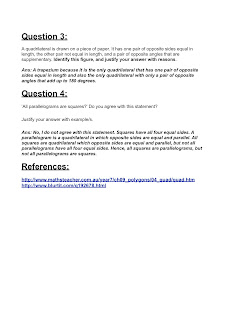Question 1
"A square is a rhombus but a rhombus is not a square".
A rhombus is a quadrilateral whose four sides all have the
same length.
However, a square has four equal sides and four equal right
angles at the corners.
If a square is turned into a rhombus, it loses its four
right angle corners. Therefore, it cannot be counted as a
square. However, if the rhombus is turned into a square, it
retains its length and still counts as a rhombus.
Question 2:
Which of the given statements is correct? Justify your
answers with examples.
A ) A square and a parallelogram are quadrilaterals.
Correct, because a square has 4 sides and 4 corners, and so
does a parallelogram.
B ) Opposite sides of a square and a parallelogram are
parallel.
For the square, it is correct as 4 corners are supposed to
be 90°.
For the parallelogram, it is also correct because even
though it does not have 4 equal angles, it still has 2 sets
of parallel lines.
href='http://img269.imageshack.us/i/trapezium.png/'><img
src='http://img269.imageshack.us/img269/5461/trapezium.png'
border='0'/></a>
C ) A trapezoid has one pair of parallel sides.
Correct as well, refer to diagram below.
href='http://img237.imageshack.us/i/squareparallelogram.png/'><img
src='http://img237.imageshack.us/img237/9694/squareparallelogram.png'
border='0'/></a>
D ) All the above
Question 4
"All parallelograms are squares?" Do you agree with this
statement?
I do not agree with this statement. A parallelogram refers
to a figure with 2 sets of parallel lines. However, a square
has 2 sets of parallel lines, 4 sides of the same length AND
must have the corner angles equal to 90° each. A rectangle
has 2 sets of parallel lines. However, it does not have 4
equal sides. Another example is a rhombus. A rhombus has 2
sets of parallel lines. However, it again does not have 4
corner angles, making it not qualify as a square.







2+copy+3-763412.jpeg)
2+copy+2-765199.jpeg)
-773548.jpg)
+2-775558.jpg)

















